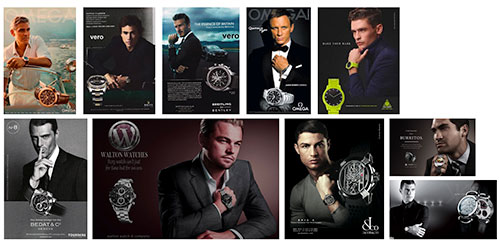 Branding started a long time ago. We know that pots, two thousand years ago had their marker’s mark on it. That then, in time, became a mark of quality. If anyone wanted a good pot (see example), they had to go to MNOVIVS, obviously. The whole village knew that. The word branding originated much later, from the German word ‘brand’ (fire), from the brand marking of cows.
Branding started a long time ago. We know that pots, two thousand years ago had their marker’s mark on it. That then, in time, became a mark of quality. If anyone wanted a good pot (see example), they had to go to MNOVIVS, obviously. The whole village knew that. The word branding originated much later, from the German word ‘brand’ (fire), from the brand marking of cows.
Brands have grown and make up a lot of things. It’s all the impressions of a brand: the price, the reputation, the product, what people say about it. A brand is not what the company says what it is: it’s what people say it is. It exists only in the minds of people.
And now brands have become so valuable, that often they’re more valuable than the company. A hundred years ago, the guy who founded Quaker Oats said: ”If this business were to split up, I would give you the land and bricks, and I would take the brand and trade marks, and I would do much better than you.” And King Solomon said: “A good name is more desirable than great riches; to be appreciated is better than silver or gold.” (Bible, proverbs 22:1)
Today we can see that the top stock traded companies have 84% of their value in intangible assets. Strong brands are better at growing and maintaining a higher price.

Brands have value because they solve specific consumer problems. Old ones like:
- How can I trust this won’t kill me?
- How do I know it works?
- Who do I blame if it doesn’t?
And modern problems:
- There’s too much stuff and it all works. Which one do I pick? Which one do I know?
It’s not about differentiation
So it’s clear everybody wants to be a brand. Everybody wants to be like Apple. And marketeers think long and hard about this. They want to differentiate their brand, and pick archetypes of Simon Sinek’s golden circles, or they plot a positioning map. But there’s zero evidence any of this works. Consumers barely notice differences among brands. And brands don’t sell to very different consumers either.

Also: 72% of Coca Cola drinkers also buy Pepsi. You would think that Pizza Hut competes mainly with Domino’s, that McDonald’s competes with Burger King, and KFC with a local Chinese competitor. But KFC competes way more with McDonald’s and Pizza Hut directly, simply because they’re the biggest in fast food. Because chicken is so popular, also McDonald’s and Pizza Hut add it to their menu. They become less differentiated as a way to grow market share.

It’s about distinctiveness
Brands work because people need help choosing. People only spend like 5 seconds to decide on a product in the supermarket. (Maybe 10 minutes for deciding a language school.) So we pick the ones we know because it feels good: Brands are primarily built through memory structures.


For a language school like GoEast, proper ‘memory structures’ would be: “Aha, I’ve seen GoEast a few times when I walked to Fudan”, “My friend told me about GoEast”, “I saw some GoEast videos before”.
This is not about being different. It’s about being distinctive. That’s how marketing works: by creating mental availability. Aside mental availability, there’s also physical availability.
Examples for GoEast are: “It appeared on the top of Google”, “I could find the information I needed on the website”, “It’s near to my home”.
But if brands don’t need to be different in order to grow, what’s creativity for?
Two truths:
- It’s better for brands to be more interesting than less interesting.
- It’s better if more people see the interesting stuff you’re doing than less people.
Marketeers care too much about being different that they don’t think about being interesting. If marketing is about building memory structures, then this is surely ineffective.
 These advertisements are totally right and therefor also totally boring. They stand the highest risk of being ignored (except… in a blog like this.) Marketeers falsely treat emotional and rational decisions as opposites: there’s only emotional response, or there is no response. (It’s more about conscious versus intuitive.) Often what is interesting has no clear logic. But it’s funny, weird, new,… different. Different?
These advertisements are totally right and therefor also totally boring. They stand the highest risk of being ignored (except… in a blog like this.) Marketeers falsely treat emotional and rational decisions as opposites: there’s only emotional response, or there is no response. (It’s more about conscious versus intuitive.) Often what is interesting has no clear logic. But it’s funny, weird, new,… different. Different?
Herein lies the great irony. Even though brands don’t need to be different to be bought, being different helps to be noticed. All chocolate can be sweet and tasty, but there’s one that had a gorilla play Phil Collins on drums. All TV’s are about sharpness and colors, but Sony plunged 250.000 balls from a hill. All cars want to be cool, but Citroën let their car drive out of a Grace Jones robot in a desert. There’s no obvious logic in this. Nor are the brands very different from the competition. But the way they present themselves are.
Being interesting is more important than being different, and can be done through:
- Creative excellence
- Breaking stereotypes, rules & taboos
- Co-creation
- Provocative cause
- Unconventional media use
- Extreme humor
- Unconventional celebrity use
谢谢!

Sources:
Shamelessly stolen from ‘How Brands Grow’, Martin Wiegel, Gerard Petherbridge, BBH Labs, IPA, and Wikipedia.



